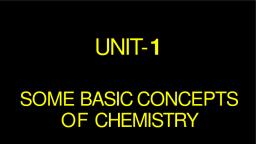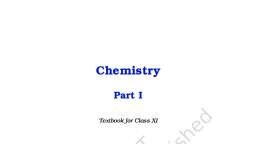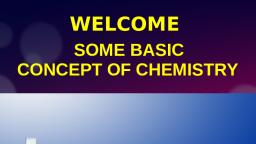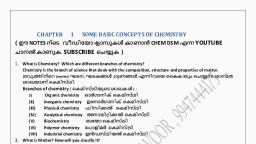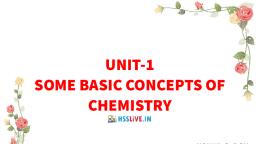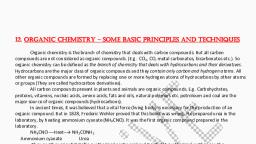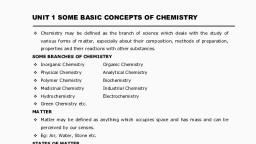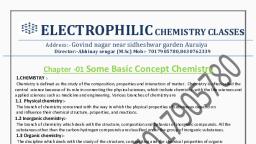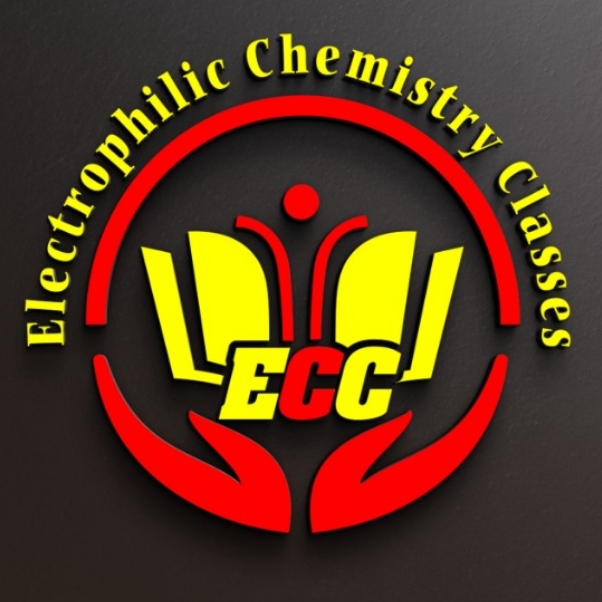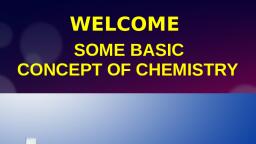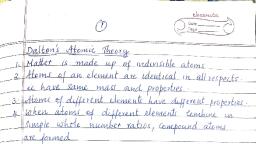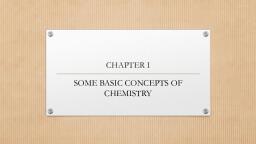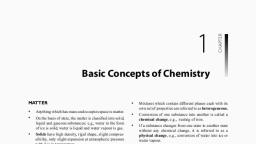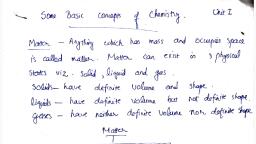Page 1 :
UNIT 1 SOME BASIC CONCEPTS OF CHEMISTRY, Chemistry may be defined as the branch of science which deals with the study of, various forms of matter, especially about their composition, methods of preparation,, properties and their reactions with other substances., SOME BRANCHES OF CHEMISTRY, Inorganic Chemistry, , Organic Chemistry, , Physical Chemistry, , Analytical Chemistry, , Polymer Chemistry, , Biochemistry, , Medicinal Chemistry, , Industrial Chemistry, , Hydrochemistry, , Electrochemistry, , Green Chemistry etc., MATTER, Matter may be defined as anything which occupies space and has mass and can be, perceived by our senses., Eg: Air, Water, Stone etc., STATES OF MATTER, Solid state, Liquid state, Gaseous state, Plasma state, Bose-Einstein condensate, Fermionic condensate, CLASSIFICATION OF MATTER, 1. PHYSICAL CLASSIFICATION, On the basis of rigidity, volume and shape, matter can exist in three physical states., a) Solids, Solids are rigid substances which have definite shape and definite volume., b) Liquids, Liquids are not rigid, but have definite volume., , , They do not have a definite shape., , They take the shape of the container in which they are placed., c) Gases, Gases have neither definite volume nor definite shape., They occupy the shape and volume of the container., 2. CHEMICAL CLASSIFICATION, a) Elements, An element is a pure substance., PREPARED BY HAIZEL G. ROY, HSST (HG) CHEMISTRY, GOVT. H.S.S. KALAMASSERY ERNAKULAM, , Page | 1
Page 2 :
It cannot be broken down into two or more simpler substances by physical and, chemical means., It is made up of only one kind of atom., Eg: Copper, Silver, Gold, Iron etc., b) Compounds, A compound is a pure substance made up of two or more elements combined, chemically in fixed proportion., Eg: H2O, NH3, CH4 etc., c) Mixtures, A mixture is made up of two or more elements or compounds or both., Eg: Brass is a mixture of Cu and Zn, Bronze is a mixture of Cu and Sn., CLASSIFICATION OF MIXTURES, a) Homogeneous Mixture, In this, the components completely mix with each other and its composition is, uniform throughout., Eg: Ethanol – Water mixture, salt solution, sugar solution etc., b) Heterogeneous Mixture, In this, the constituents are not uniformly mixed and the properties and composition, vary throughout the mixture., Eg: Gun powder is a mixture of charcoal, sulphur and nitre., Muddy water, Chalk powder in water etc., PROPERTIES OF MATTER, a) Physical Properties, Properties which can be measured or observed without changing the identity or the, composition of the substance., Eg: Colour, odour, melting point, boiling point, density etc., b) Chemical Properties, Properties in which a chemical change occur., Eg: Chemical reactions of different substances., MASS AND WEIGHT, Mass of a substance is the amount of matter present in it., The mass of a substance is constant., The SI unit of mass is kg., Weight is the force exerted by gravity on an object., Weight may vary from one place to another due to change in gravity., DENSITY, Density of a substance is its amount of mass per unit volume., Density , , Mass, Volume, , PREPARED BY HAIZEL G. ROY, HSST (HG) CHEMISTRY, GOVT. H.S.S. KALAMASSERY ERNAKULAM, , Page | 2
Page 3 :
The SI unit of density is kg/m3, TEMPERATURE, Temperature is the degree of hotness of a body., Three common scales are used to measure temperature., , , They are degree Celsius (º C), degree Fahrenheit (º F) and Kelvin (K)., , The Celsius scale is represented between zero degree to hundred degree., Celsius and Fahrenheit scale is represented between 32º to 212º F., , , , , The Fahrenheit scale is related to Celsius scale as follows, 9, º F = ( º C) + 32, 5, The Kelvin scale is related to Celsius scale as follows, K = º C + 273.15, , ACCURACY, It is the agreement of a particular value to the true value of the result., PRECISION, Precision is the closeness of various measurements for the same quantity., Eg: If the true value for a result is 2.00 g and a student ‘A’ takes two measurements, and reports the result as 1.95 g and 1.93 g., These values are precise but are not accurate., SIGNIFICANT FIGURES, Significant figures are meaningful digits which are known with certainty., RULES FOR DETERMINING THE SIGNIFICANT FIGURES, All non zero digits are significant., Eg: 235 has 3 significant figures., Zero’s to the left of the first non zero digit are not significant., Eg: 0.002 has only one significant figure., Zero’s between non zero digits are significant., Eg: 3.02 has 3 significant figures., Zero’s to the right of the decimal point are significant., Eg:2.00 has 3 significant figures., LAWS OF CHEMICAL COMBINATION, 1. LAW OF CONSERVATION OF MASS, This law was put forth by Antoine Lavoisier., The law states that matter can neither be created nor be destroyed., Eg: 12 g carbon combines with 32 g oxygen to form 44 g CO2., Here the total mass of the reactants is equal to the total mass of the products., 2. LAW OF DEFINITE PROPORTION, This law was put forth by Joseph Proust., The law states that, the same compound always contain the same elements, combined in the same fixed proportion by mass., PREPARED BY HAIZEL G. ROY, HSST (HG) CHEMISTRY, GOVT. H.S.S. KALAMASSERY ERNAKULAM, , Page | 3
Page 4 :
Eg: NaCl may be obtained from sea water., It is also prepared by chemical reactions between NaOH and HCl., , , , These samples on analysis are found to contain Na and Cl in the ratio 23:35.5 by, mass., 3. LAW OF MULTIPLE PROPORTION, This law was put forth by Dalton., The law states that when two elements combines to form more than one compound,, the different masses of one of the elements which combines with a fixed mass of the, other element are in the ratio of simple whole numbers., Eg: Carbon combines with oxygen to form two different oxides CO and CO2 under, different conditions., In CO2, 12 g of carbon combines with 32 g of oxygen and in carbon monoxide 12 g, carbon combines with 16g of oxygen., In these two cases, the mass of oxygen combining with the fixed mass of carbon are, in the ratio 16:32 or 1:2., 4. GAY LUSSAC’S LAW OF GASEOUS VOLUMES, This law was put forth by Gay Lussac., The law states that, when gases combine to form gaseous products, a simple ratio, exists between the volumes of the reactants and the products at constant, temperature and pressure., Eg: When H and Cl combine to form HCl, a simple ratio by volume exists between the, gases H2, Cl2 and HCl at constant temperature and pressure., 5. AVOGADRO’S LAW, This law was put forth by Anvogadro., The law states that equal volume of all gases under the same conditions of, temperature and pressure contains the same number of molecules., DALTONS ATOMIC THEORY, In 1808, John Dalton proposed an atomic theory., POSTULATES, Matter is made up of small indivisible particles called atoms., Atoms of the same element are identical in mass and other properties., Atoms of different elements are different in properties., Atoms can neither be created nor be destroyed., Since atoms are indivisible, they combine in small whole numbers to form, compound atoms called molecules., ATOMS AND MOLECULES, Atom is the smallest particle of an element., Molecules are the smallest particle of a substance., , , A molecule has all the properties of that substance., , PREPARED BY HAIZEL G. ROY, HSST (HG) CHEMISTRY, GOVT. H.S.S. KALAMASSERY ERNAKULAM, , Page | 4
Page 5 :
TYPES OF MOLECULES, Based on the type of atoms, there are two types of molecules., Homonuclear molecule and Heteronuclear molecule., A molecule containing only one type of atom is called homonuclear molecule., Eg. H2, O2, N2, O3 etc., Heteronuclear molecules contain different types of atoms., E.g. CO2, H2O, C6H12O6, NH3 etc., Based on the no. of atoms there are three types of molecules., Monoatomic, diatomic and polyatomic molecules., Monoatomic molecules contain only one atom., Eg. All metals, noble gases like He, Ne, Ar etc., Diatomic molecules contain 2 atoms., E.g. H2, O2, N2, halogens (F2, Cl2, Br2 and I2), Polyatomic molecules contain more than two atoms., Eg. ozone (O3), Phosphorus (P4), Sulphur (S8) etc., ATOMIC MASS, Atomic mass of an element is defined as a number which expresses how many times, the mass of one atom of the element is greater than, , 1, 12, , th, , the mass of a carbon-12, , atom., Atomic mass =, , Mass of one atom of the element, 1, 12, , x mass of one C-12 atom, , AVERAGE ATOMIC MASS, The average atomic mass of an element is the sum of the masses of its isotopes,, each multiplied by its natural abundance, We can calculate an average atomic mass of an element by considering the atomic, mass of the isotopes and their relative abundance., Eg: Chlorine has two isotopes, , 35, , Cl and, , 37, , Cl in the ratio 3:1., , So the average atomic mass Cl = (3 x 35 + 1 x 37) / 4 = 35.5, ATOMIC MASS UNIT, , , One atomic mass unit is defined as mass exactly equal to, , 1, 12, , th, , the mass of one, , carbon-12 atom. Amu is also known as unified mass. (u), , , 1 amu = 1.66056 x 10―24, , , , Eg: Mass of an atom of hydrogen = 1.6736 x 10 ―24, , , , The mass of hydrogen atom in terms of amu =, , 1.6736x10, , 24, , g, 24, 1.66056x10, g, , = 1.0078 amu, PREPARED BY HAIZEL G. ROY, HSST (HG) CHEMISTRY, GOVT. H.S.S. KALAMASSERY ERNAKULAM, , Page | 5
Page 6 :
= 1.008 amu, MOLECULAR MASS, Molecular mass is the sum of atomic masses of the elements present in a molecule., It is obtained by multiplying the atomic mass of each element by the number of its, atoms and adding them together., GRAM ATOMIC MASS OR GRAM ATOM, Atomic mass expressed in grams is called gram atomic mass or simply gram atom., Mass in grams, No. of gram atoms =, , Gram atomic mass, , GRAM MOLECULAR MASS OR GRAM MOLE, The molecular mass expressed in grams is called gram molecular mass or simply, gram mole., Mass in grams, No. of gram mole =, , Gram molecular mass, , FORMULA MASS, The formula mass of a molecule is the sum of the atomic weights of the atoms in the, empirical formula of the concept., Eg: The formula mass of NaCl = Atomic mass of sodium + Atomic mass of Cl, = 23 + 35.5 = 58.5, MOLE CONCEPT, Mole is the unit used for counting very large number of particles like atoms,, molecules or ions., This is equal to 6.023 x 1023. Mole is represented by the symbol ‘mol’., HOW TO FIND THE NUMBER OF MOLES?, Mass, Number of moles, =, Molar Mass, OR, No. of molecules, Number of moles, =, Avogadro Number, OR, Volume of the gas at STP, Number of moles, =, Standard Molar Volume, MOLAR VOLUME, The volume occupied by one mole of a gas is called molar volume or gram molar, volume. One mole of all gases occupies 22.4 L at STP., STANDARD MOLAR VOLUME (22400 mL or 22.4 L), One mole of any gas at STP occupies a volume of 22400 mL or 22.4 L., This volume is called Standard molar volume., PREPARED BY HAIZEL G. ROY, HSST (HG) CHEMISTRY, GOVT. H.S.S. KALAMASSERY ERNAKULAM, , Page | 6
Page 7 :
PERCENTAGE COMPOSITION, Mass of that element in the compound, Mass percentage of an element =, , x 100, Molar mass of the compound, , Eg: Molar mass of water = 18g, , 1x2, x100 11.1%, 18, 16, =, x100 88.9%, 18, , Mass percentage of Hydrogen =, Mass percentage of oxygen, EMPIRICAL FORMULA, , It represents the simplest whole number ratio of various atoms present in a, compound., Eg: Empirical formula of Benzene is CH., Glucose – CH2O, Hydrogen Peroxide - HO, MOLECULAR FORMULA, It gives the exact number of different types of atoms present in a molecule of a, compound., Eg: Molecular formula of Benzene is C6H6., RELATION BETWEEN EMPIRICAL FORMULA AND MOLECULAR FORMULA, Molecular formula = n x Empirical Formula, , n=, , Molecular Mass, Empirical Formula Mass, , STOICHIOMETRY, The word Stoichiometry is defined from two Greek words ‘stoichion’ meaning, element and ‘metron’ meaning measure., It deals with the calculation of masses of the reactants and the products involved in a, chemical reaction., Eg: CH4 2O2 CO2 2H2O, Here 1 mol of CH4 reacts with 2 moles of O2 to give one mole of CO2 and 2 moles of, H2O., OR, 16g of CH4 reacts with 64g of O2 to give 44g of CO2 and 36 g of H2O, OR, 22.4L of CH4 reacts with 44.8L of oxygen to give 22.4L of CO2 and 44.8L of H2O., CHEMICAL EQUATION, It is the representation of a chemical reaction by symbols and formulae., Here the reactants are written on the left hand side, The products are written on the right hand side., The substances which participate in a chemical reaction are called reactants., PREPARED BY HAIZEL G. ROY, HSST (HG) CHEMISTRY, GOVT. H.S.S. KALAMASSERY ERNAKULAM, Page | 7
Page 8 :
The substances which are formed as a result of a reaction are called products., REACTIONS IN SOLUTIONS, 1. MASS PERCENT, Mass percentage of a component in a given solution is the mass of the compound per, 100g of the solution., Mass of the component in the solution, Mass percentage, , =, , Total mass of the solution, , x 100, , 2. MOLE FRACTION, It is the ratio of number of moles of a particular component to the total number of, moles of the solution., No. of moles of the component, Mole fraction of a component =, Total No. of moles of all the components, If a substance ‘A’ dissolves in a substance ‘B’ and their number of moles are nA and, nB respectively. Then the mole fractions of A and B are given as, Mole fraction of A, XA =, , nA, nA nB, , Mole fraction of B, XB =, , nB, nA nB, , n, , n, , A , B 1, XA XB , nA nB nA nB, 3. MOLARITY (M), , , It is defined as the number of moles of the solute in one litre of the solution., No. of moles of solute, Molarity, M =, Volume of the solution in litres, OR, Molarity, M =, , Mass of solute per litre, Molar mass of solute, , 4. MOLALITY (m), It is defined as the number of moles of solute present in 1 kg of solvent. It is denoted, by ‘m’., No. of moles of solute, Molality, m =, Mass of solvent in kg, NOTE:, Mass Percentage, mole fraction and molality are independent of temperature, whereas, molarity is a function of temperature. This is because volume depends on temperature, and the mass does not., PREPARED BY HAIZEL G. ROY, HSST (HG) CHEMISTRY, GOVT. H.S.S. KALAMASSERY ERNAKULAM, , Page | 8
Page 9 :
LIMITING REACTANT OR LIMITING REAGENT, The reagent which is completely consumed in a chemical reaction is called limiting, reactant or limiting reagent., , PREPARED BY HAIZEL G. ROY, HSST (HG) CHEMISTRY, GOVT. H.S.S. KALAMASSERY ERNAKULAM, , Page | 9
